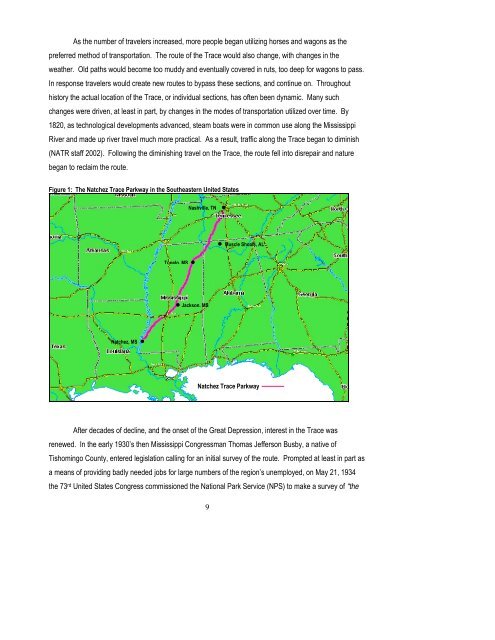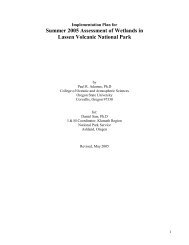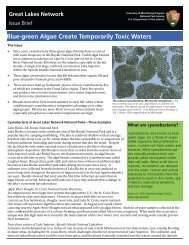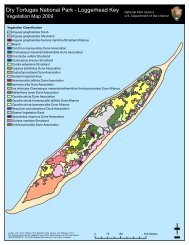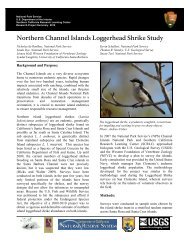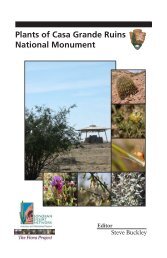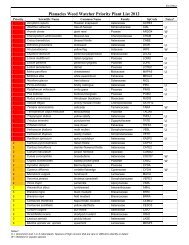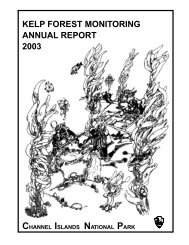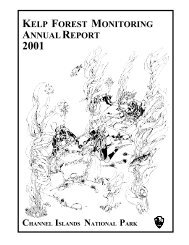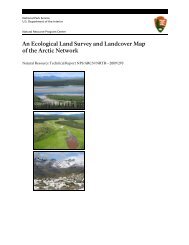- Page 1 and 2: THE VASCULAR FLORA OF THE NATCHEZ T
- Page 3 and 4: Field observations were made of two
- Page 5 and 6: A. Kruse 2004 TABLE OF CONTENTS EXE
- Page 7: LIST OF TABLES Table 1 Natchez Trac
- Page 11 and 12: to heavily forested sites (Figure 2
- Page 13 and 14: A. Kruse 2004 1.3 Climate Due to th
- Page 15 and 16: undoubtedly have negative impacts o
- Page 17 and 18: vouchers collected as part of this
- Page 19 and 20: any extant populations (Rosso and R
- Page 21 and 22: Table 4: Summary of Request for Spe
- Page 23 and 24: Table 5: Summary of Field Dates and
- Page 25 and 26: A comparison was also made of the s
- Page 27 and 28: 3.3.6 Endemism of the Natchez Trace
- Page 29 and 30: Table 11: Records of Rare, Threaten
- Page 31 and 32: TABLE 12: Verifcation of Voucher Sp
- Page 33 and 34: The Vascular Flora of the Natchez T
- Page 35 and 36: The Vascular Flora of the Natchez T
- Page 37 and 38: The Vascular Flora of the Natchez T
- Page 39 and 40: The Vascular Flora of the Natchez T
- Page 41 and 42: The Vascular Flora of the Natchez T
- Page 43 and 44: The Vascular Flora of the Natchez T
- Page 45 and 46: The Vascular Flora of the Natchez T
- Page 47 and 48: The Vascular Flora of the Natchez T
- Page 49 and 50: The Vascular Flora of the Natchez T
- Page 51 and 52: The Vascular Flora of the Natchez T
- Page 53 and 54: The Vascular Flora of the Natchez T
- Page 55 and 56: The Vascular Flora of the Natchez T
- Page 57 and 58: The Vascular Flora of the Natchez T
- Page 59 and 60:
The Vascular Flora of the Natchez T
- Page 61 and 62:
The Vascular Flora of the Natchez T
- Page 63 and 64:
The Vascular Flora of the Natchez T
- Page 65 and 66:
The Vascular Flora of the Natchez T
- Page 67 and 68:
The Vascular Flora of the Natchez T
- Page 69 and 70:
The Vascular Flora of the Natchez T
- Page 71 and 72:
The Vascular Flora of the Natchez T
- Page 73 and 74:
The Vascular Flora of the Natchez T
- Page 75 and 76:
The Vascular Flora of the Natchez T
- Page 77 and 78:
The Vascular Flora of the Natchez T
- Page 79 and 80:
The Vascular Flora of the Natchez T
- Page 81 and 82:
The Vascular Flora of the Natchez T
- Page 83 and 84:
The Vascular Flora of the Natchez T
- Page 85 and 86:
The Vascular Flora of the Natchez T
- Page 87 and 88:
The Vascular Flora of the Natchez T
- Page 89 and 90:
The Vascular Flora of the Natchez T
- Page 91 and 92:
The Vascular Flora of the Natchez T
- Page 93 and 94:
The Vascular Flora of the Natchez T
- Page 95 and 96:
The Vascular Flora of the Natchez T
- Page 97 and 98:
The Vascular Flora of the Natchez T
- Page 99 and 100:
The Vascular Flora of the Natchez T
- Page 101 and 102:
The Vascular Flora of the Natchez T
- Page 103 and 104:
The Vascular Flora of the Natchez T
- Page 105 and 106:
The Vascular Flora of the Natchez T
- Page 107 and 108:
The Vascular Flora of the Natchez T
- Page 109 and 110:
The Vascular Flora of the Natchez T
- Page 111 and 112:
The Vascular Flora of the Natchez T
- Page 113 and 114:
The Vascular Flora of the Natchez T
- Page 115 and 116:
The Vascular Flora of the Natchez T
- Page 117 and 118:
The Vascular Flora of the Natchez T
- Page 119 and 120:
The Vascular Flora of the Natchez T
- Page 121 and 122:
The Vascular Flora of the Natchez T
- Page 123 and 124:
The Vascular Flora of the Natchez T
- Page 125 and 126:
The Vascular Flora of the Natchez T
- Page 127 and 128:
The Vascular Flora of the Natchez T
- Page 129 and 130:
The Vascular Flora of the Natchez T
- Page 131 and 132:
The Vascular Flora of the Natchez T
- Page 133 and 134:
The Vascular Flora of the Natchez T
- Page 135 and 136:
The Vascular Flora of the Natchez T
- Page 137 and 138:
The Vascular Flora of the Natchez T
- Page 139 and 140:
Godfrey, R.K. and J.W. Wooten. 1981
- Page 141 and 142:
APPENDIX A Collection Locations by
- Page 143 and 144:
Site Date Site Description GPS Coor
- Page 145 and 146:
Site Date Site Description GPS Coor
- Page 147 and 148:
Site Date Site Description GPS Coor
- Page 149 and 150:
Site Date Site Description GPS Coor
- Page 151 and 152:
Site Date Site Description GPS Coor
- Page 153 and 154:
Site Date Site Description GPS Coor
- Page 155 and 156:
Site Date Site Description GPS Coor
- Page 157 and 158:
Site Date Site Description GPS Coor
- Page 159 and 160:
Site Date Site Description GPS Coor
- Page 161 and 162:
Site Date Site Description GPS Coor
- Page 163 and 164:
Site Date Site Description GPS Coor
- Page 165 and 166:
Site Date Site Description GPS Coor
- Page 167 and 168:
Site Date Site Description GPS Coor
- Page 169 and 170:
Site Date Site Description GPS Coor
- Page 171 and 172:
Site Date Site Description GPS Coor
- Page 173 and 174:
Site Date Site Description GPS Coor
- Page 175 and 176:
Site Date Site Description GPS Coor
- Page 177 and 178:
Site Date Site Description GPS Coor
- Page 179 and 180:
Site Date Site Description GPS Coor
- Page 181 and 182:
Site Date Site Description GPS Coor
- Page 183 and 184:
Site Date Site Description GPS Coor
- Page 185 and 186:
APPENDIX B Endemic Vascular Plants
- Page 187 and 188:
Family Taxon NATR Voucher State Ref
- Page 189 and 190:
APPENDIX C Locations of Rare, Threa
- Page 191 and 192:
some degree of color variation in t
- Page 193 and 194:
Taxon State Location Last Verified
- Page 195 and 196:
APPENDIX D Alphabetical List (by Ge
- Page 197 and 198:
Taxon Common Name(s) Codes Voucher
- Page 199 and 200:
Taxon Common Name(s) Codes Voucher
- Page 201 and 202:
Taxon Common Name(s) Codes Voucher
- Page 203 and 204:
Taxon Common Name(s) Codes Voucher
- Page 205 and 206:
Taxon Common Name(s) Codes Voucher
- Page 207 and 208:
Taxon Common Name(s) Codes Voucher
- Page 209 and 210:
Taxon Common Name(s) Codes Voucher
- Page 211 and 212:
Taxon Common Name(s) Codes Voucher
- Page 213 and 214:
Taxon Common Name(s) Codes Voucher
- Page 215 and 216:
Taxon Common Name(s) Codes Voucher
- Page 217 and 218:
Taxon Common Name(s) Codes Voucher
- Page 219 and 220:
Taxon Common Name(s) Codes Voucher
- Page 221 and 222:
Taxon Common Name(s) Codes Voucher
- Page 223 and 224:
Taxon Common Name(s) Codes Voucher
- Page 225 and 226:
Taxon Common Name(s) Codes Voucher
- Page 227 and 228:
Taxon Common Name(s) Codes Voucher
- Page 229 and 230:
Taxon Common Name(s) Codes Voucher
- Page 231 and 232:
Taxon Common Name(s) Codes Voucher
- Page 233 and 234:
Taxon Common Name(s) Codes Voucher
- Page 235 and 236:
Taxon Common Name(s) Codes Voucher
- Page 237 and 238:
Taxon Common Name(s) Codes Voucher
- Page 239 and 240:
Taxon Common Name(s) Codes Voucher
- Page 241 and 242:
Taxon Common Name(s) Codes Voucher
- Page 243 and 244:
Taxon Common Name(s) Codes Voucher
- Page 245 and 246:
Taxon Common Name(s) Codes Voucher
- Page 247 and 248:
Taxon Common Name(s) Codes Voucher
- Page 249 and 250:
Taxon Common Name(s) Codes Voucher
- Page 251 and 252:
Taxon Common Name(s) Codes Voucher
- Page 253 and 254:
Taxon Common Name(s) Codes Voucher
- Page 255 and 256:
Taxon Common Name(s) Codes Voucher
- Page 257 and 258:
Taxon Common Name(s) Codes Voucher
- Page 259 and 260:
Taxon Common Name(s) Codes Voucher
- Page 261 and 262:
Taxon Common Name(s) Codes Voucher
- Page 263 and 264:
Taxon Common Name(s) Codes Voucher
- Page 265 and 266:
Taxon Common Name(s) Codes Voucher
- Page 267 and 268:
Taxon Common Name(s) Codes Voucher
- Page 269 and 270:
Taxon Common Name(s) Codes Voucher
- Page 271 and 272:
Taxon Common Name(s) Codes Voucher
- Page 273 and 274:
Taxon Common Name(s) Codes Voucher
- Page 275 and 276:
Taxon Common Name(s) Codes Voucher
- Page 277 and 278:
Taxon Common Name(s) Codes Voucher
- Page 279 and 280:
Taxon Common Name(s) Codes Voucher
- Page 281 and 282:
Taxon Common Name(s) Codes Voucher


